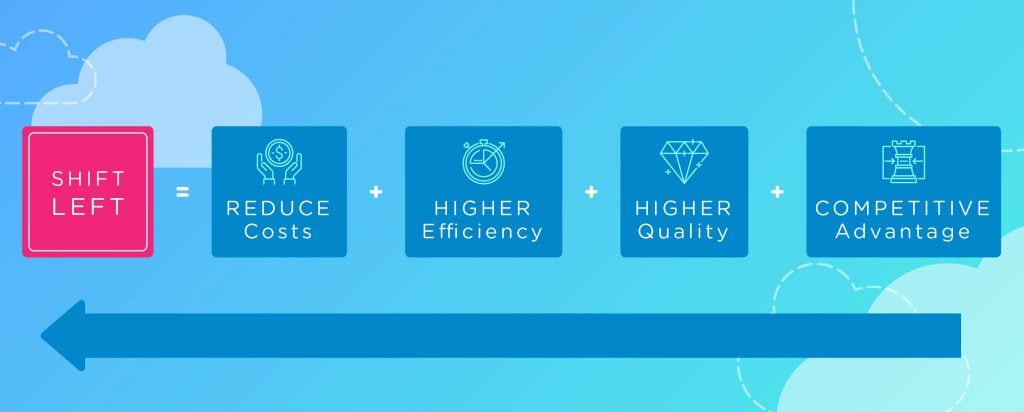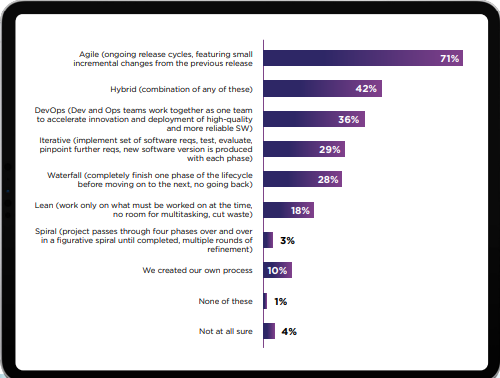From quality assurance to quality engineering: Why you should use shift-left testing. Learn with Abstracta’s expertise.


If you work in the software industry, you’ve most likely heard about “shift-left testing” from conferences, blog posts, industry publications, co-workers, etc.
With Agile practices and DevOps increasing in popularity, “shift-left” is the answer to how QA fits in and makes them a reality in your organization, not just an aspiration. This shift changes the way you look at testing – instead of traditional QA, it becomes QE: Quality Engineering.
In this article, we’re diving deep into why shift-left testing is a total game-changer. We’ll explore how it can cut costs, boost efficiency, and give us that competitive edge we’ve been looking for.
Ready to transform your development process? Explore our end-to-end software testing services!
What is The Shift-left Testing Approach?
The shift-left testing approach involves moving testing activities to the earlier stages of the software development lifecycle. Instead of waiting until the end to test, development and QA teams collaborate from the start to identify and fix issues as early as possible.
Not only does this improve software quality but also reduces costs and development time.
This means working together with development and operations and analyzing quality during every stage of development as shown in the graphic below. For example, testers have to jump in and take a more proactive role even before development starts by being present during the gathering of requirements.


Key Activities for Testers in Shift-left Testing
Here are some of the crucial tasks testers take on in a shift-left approach:
- Helping developers implement unit testing: Testers collaborate with developers to create and run unit tests, verifying that individual components work correctly from the get-go.
- Planning, creating, and executing integration test cases: Testers design and execute tests that check how different parts of the system interact, catching issues early in the integration phase.
- Automating tests: Testers create and deploy automated tests to streamline the testing process, making it faster and more reliable throughout the development cycle.
- Employing virtualized services at every stage and component level: By using virtualized services at every stage and component level, testers can simulate different parts of the system, making it easier to test components in isolation and in various scenarios.
- Gathering, prioritizing, and processing feedback: Testers collect feedback from various stages of development, prioritize it based on impact, and address it promptly.
Process Changes During the Shift
Shifting left also brings about some significant process changes:
- Frequent code integration: Rather than waiting weeks to add code to that of the rest of the team, integrate code every day, or even several times a day, to catch issues early.
- Continuous quality analysis: Instead of detecting problems at the end, continuously analyze quality as development progresses, addressing issues as soon as they arise.
- Early involvement of testers: Get testers involved from the very beginning, even during the requirements gathering phase, to identify potential issues early.
- Collaborative development: Foster a culture of collaboration between developers, testers, and operations and make quality a shared responsibility throughout the development process.
What is the Role of Shift-Left Testing?
The main role of shift-left testing is to detect and fix errors as early as possible in the development cycle. It’s all about testing early, from the very beginning. By involving testers from the outset, design, and requirements, teams can identify code issues before they become major headaches. This results in more robust software and fewer unpleasant surprises at the end of the project.
Why Make the Shift if You Haven’t Yet?


Now that we’ve covered the basics of shift-left testing, it’s time to dive into why making this shift is so crucial. Let’s explore the key benefits that can transform your development process and give you a competitive edge.
In this section, we’ll provide just three main benefits of shifting left: reduced costs, increased efficiency and quality, and gaining a competitive edge.
Reduce the Cost of Testing & Development
It is still true what Larry Smith said over 20 years ago when the “shift-left” concept was first introduced, “Bugs are cheap when caught young.”
One of the aims of Agile testing is to detect errors as soon as possible. What we mean by as soon as possible is: as soon after the exact moment in which the error was inserted into the system.
When you test with every build (especially during unit testing), you may find smaller errors that are easier to detect, locate, and fix at a lower cost. Maintaining quality as you go also mitigates the tremendous costs and unnecessary work of going back and re-doing certain things.
Want to know how much money you can save with test automation? Check out this post on the ROI of test automation.
Increase Efficiency & Quality
We often find that the increased levels of automation when shifting left allow for:
- Increasing test coverage by running more tests in the same amount of time
- Freeing up time for testers to focus on more challenging and rewarding tasks
- Reducing human error
- Monitoring performance over time
- Code quality checks
- Built-in security checks
- Reducing issues in production (that users will face)
Beyond these benefits, being able to start testing sooner invariably results in more quality, as testers are no longer rushing to find all the errors at the end.
Gain a Competitive Edge
Shifting left your QA gives you a competitive edge in two ways: you can speed up time to market and attract top talent.
About staying competitive in today’s ever-changing technological landscape, Alon Girmonsky, founder of BlazeMeter, said it best:
“Today, the barrier to compete is minimal, and the only way to defend one’s stature is by innovating in short iterations… meaning adopting Agile.” – Alon Girmonsky
As we can all agree that it is important to deliver software more quickly, it also shouldn’t be rushed out the door. Shift-left testing answers the problem of accelerating development without sacrificing quality.
The Shift-Left Revolution: A Game-Changer for Agile Testing
Secondly, shift-left testing is what software developers and test engineers expect today from their organizations, officially becoming mainstream with just over 70% of IT workers reportedly using Agile in their software development lifecycle (SDLC).
According to the 2023 State of Agile Report by Digital.ai, 71% of organizations have adopted Agile practices in some form. Additionally, 42% of respondents said their organizations use a hybrid model that includes Agile, DevOps, or other methodologies.


Interestingly, the larger the organization, the more likely it is to use a hybrid model—49% of large companies and 45% of medium-sized companies are doing so. Bigger teams are also more likely to still use Waterfall, with 31% of large and 38% of medium-sized companies reporting its use.
Agile and Hybrid Models: Dominating the Testing Landscape
One key finding from the 2024 State of Testing™ Report by PractiTest is the continued dominance of Agile methodologies, with 92% of organizations adopting Agile or Agile-like practices. While the 2023 State of Agile Report by Digital.ai showed 71% of organizations adopting Agile practices, the 2024 State of Testing™ Report by PractiTest reveals even higher adoption.


In parallel, the PractiTest report also highlights the rise of shift-left approaches, with Behavior Driven Development (BDD) increasing to 26% and Test Driven Development (TDD) to 23%.
These findings underline the industry’s push for earlier testing in the development process. Despite this, 21% of organizations still rely on Waterfall models, indicating a slower transition in certain sectors.
All in all, if you want to be an attractive employer or at least stay on par with your competitors, adopting modern practices is essential. Testers and developers alike seek to master these methodologies, which not only boost your team’s agility and innovation but also position you as a leader in the evolving tech landscape.
When Shift-Left Testing Doesn’t Work


Maybe you have heard all of those benefits already, but you are STILL not convinced about shift-left testing for this reason: you’ve seen that even Agile teams can face the same bottlenecks as seen in Waterfall.
For example, as Shridhar Mittal, former GM of Application Delivery at CA Technologies, explains, “Due to the complexity of environments and composite applications, Agile teams are often stuck waiting in a queue once all of the pieces come together in the performance and user acceptance testing phases.”
The solution he provides that we agree with is utilizing service virtualization. Service virtualization emulates the behavior of essential components that will be present in production, enabling integration tests to take place much earlier in development. This is how you can eliminate that key bottleneck, while also benefitting from eliminating errors earlier on.
Along with service virtualization, you have several tools to set up your automated systems and CI such as Jenkins, CruiseControl, Bamboo, and TeamCity, which all have web management interfaces. Or, you could go with a cloud solution like Amazon Pipeline Code, TravisCI, CircleCI, Codeship, and Microsoft’s Visual Studio Team Services.
One Important Note
Just having these tools in place does not ensure a successful shift and does not imply quality engineering. There are several preconditions and a level of testing maturity that must be reached in order to achieve Continuous / Agile / Shift-left testing.
For example, a precondition for test automation would be having the appropriate test environments set up. Without this and several other preconditions, your shifting of QA to the left will be problematic, at the least.
Is your team ready to shift-left? Take our software testing maturity assessment to find out!
Wrapping Up
With Agile now the standard, it’s essential to adopt shift-left testing as a key strategy to increase quality, boost efficiency, reduce costs and risks, and stay competitive.
Shift-left testing isn’t about focusing on a testing phase. It’s about running software tests from the very beginning, embedding testing early and maintaining it throughout the development lifecycle. This approach emphasizes early unit and integration testing, along with automating tests where possible, to identify issues sooner.
Complementing shift-left with continuous testing and shift-right testing (meaning testing in production) further enhances this strategy, helping teams deliver high-quality software at a faster pace.
Who wouldn’t want that?
How We Can Help You
With over 16 years of experience and a global presence, Abstracta is a leading technology solutions company specializing in end-to-end software testing services and AI software development.
We believe that actively bonding ties propels us further and helps us enhance our clients’ software. That’s why we’ve forged robust partnerships with industry leaders like Microsoft, Datadog, Tricentis, and Perforce BlazeMeter, empowering us to incorporate cutting-edge technologies.
Testing Maturity Model
Our software testing maturity model is a comprehensive framework that helps teams improve the quality of their software testing efforts, including all types of software testing. This model emphasizes the importance of a well-constructed test environment and the use of reliable testing tools to meet the needs of users and stakeholders.
Processes, Technology, and People
Effective processes and tools are crucial, but they must also align with the skills and capabilities of your team members. Our approach allows us to create a well-rounded, adaptable test plan that fosters active participation and effectively meets test deliverables.
Our holistic approach enables us to support you across the entire software development life cycle.
Visit our Test Strategy Services webpage and contact us to discuss how we can help you grow your business.


Follow us on Linkedin & X to be part of our community!
FAQs
What Are The Four Types of Shift-Left Testing?
The four types of shift-left testing include traditional shift-left testing, incremental shift-left testing, Agile/DevOps, and model-based testing.
- Traditional testing: Moves functional testing to the early stages, catching issues right from the start and saving time and money down the line.
- Incremental testing: Integrates testing into each development increment, so every new feature gets tested immediately, maintaining high quality at every step.
- Agile/DevOps: Combines agile and DevOps practices for continuous testing throughout the development process. It’s like having a built-in safety net that keeps everything running smoothly as you go.
- Model-based testing: Uses models to design and run tests, catching design errors early. Think of it as having a detailed map that guides you to build everything correctly from the ground up.
What is The Difference Between Shift-left and TDD?
Shift-left and TDD (Test-Driven Development) are complementary but distinct approaches. Shift-left is a general philosophy advocating for testing as early as possible in the development cycle. In contrast, TDD involves writing tests before the production code. In TDD, tests guide the development of the software. Shift-left, however, is broader and includes various practices and types of testing.
What is The Difference Between TDD and Shift-Right?
TDD (Test-Driven Development) and shift-right are also are also distinct strategies. TDD focuses on writing tests before the production code to guide software development. Shift-right, on the other hand, emphasizes testing and monitoring in the production environment. While TDD aims to catch issues early in the development process, shift-right focuses on boosting quality and performance in the live environment, often using techniques like A/B testing, canary releases, and real-time monitoring.
Recommended for You
Shift-Left Testing & Shift-Right Testing, a Possible Strategy
Tags In


Sofia Palamarchuk
Related Posts
We Want our DevOps Venn Diagram Circle Back – Plus One!
In this guest post, Agile test experts, Lisa Crispin and Janet Gregory, share their views on DevOps and Software Quality Close to a decade ago, the DevOps movement grew out of agile development. It was defined as the intersection of “Dev”, “Ops”, and “QA”. (Source:…
Why So Much Talk Around DevOps Culture?
DevOps is taking software development by storm… Here’s what it means for testers. DevOps is a little word that has become very much the trend. It comes from uniting the words Development and Operations, with the idea of joining two worlds between which there is…
7 Comments
Leave a Reply Cancel reply
Search
Contents









I really enjoyed your article. I especially like the sentiment that QA can help Development with their unit testing. This concept is a hard sell to the QA team that feels overworked with their own testing tasks. Providing development scenarios that THEY can execute is the first step. Developers will find a way to automate those scenarios and voila — you have unit tests!
One problem I have is that Mind-Set of the Employer where they think that Testers / QAs are some-what lower than other job group;; thus, they will usually get less pay, less appreciated, and more like a pawn. Might just me, but that how I feel.
Awesome article…It would be more clear if the difference between Agile and shift left testing…Thank you so much.
Thanks Manjunath!
Awesome article!!!
Thanks Brian!
Would like to go through the book